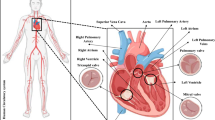Abstract
A lumped parameter compartmental model for the nonsteady flow of the cerebrovascular fluid is constructed. The model assumes constant resistances that relate fluid flux to pressure gradients, and compliances between compartments that relate fluid accumulation to rate of pressure changes. Resistances are evaluated by using mean values of artery and cerebrospinal fluid (CSF) fluxes and mean compartmental pressures. Compliances are then evaluated from clinical data of simultaneous pulse wave recordings in the different compartments. Estimate of the average CSF compartmental deformation, based on the compliance between the CSF and brain tissue compartments, proves to be of the order of magnitude of actual experimental measurements.
Similar content being viewed by others
References
Agarwal, G.C. Fluid flow a special case. In: Jacobs, J.E.; Stark, L., eds. Biomedical Engineering. Philadelphia: Brow, J.H.V., F.A. Davis Co.; 1971: pp. 69–81.
Bering, E.A., Jr. Choroid plexus and arterial pulsation of cerebrospinal fluid. Demonstration of the choroid plexuses as a cerebrospinal pump. Arch. Neuro. Psychiatry 73:167–172; 1955.
Cutaler, R.W.P. Formation and observation of CSF in man. Brain 9:70; 1968.
Davson, H. Intracranial and intraocular fluids. In: Hamilton, W.F., ed. Handbook of Physiology: Section 1—Neurophysiology, Vol. III. Washington, D.C.: American Physiological Society; 1960: pp. 1761–1788.
Greenberg, J.H.; Reivich, M.; Noordergraaf, A. A model of cerebral blood flow control in Hypercapnia. Annals of Biomedical Engineering 6:453–491; 1978.
Guyton, A.C. Function of the human body 3rd ed. Philadelphia: 1969.
Hakim, S.; Venegas, J.G.; Burton, J.D. The physics of the cranial cavity, hydrocephalus and normal pressure: mechanical interpretation and mathematical models. Sur. Neurol. 5:187–210; 1976.
Hamit, H.F.; Beal, A.C., Jr.; DeBakey, M.E. Hemodynamic influences upon brain and cerebrospinal fluid pulsations and pressures. J. Trauma 5:174–184; 1965.
Karni, Z.; Bear, J.; Sorek, S.; Pinczewski, Z. Quasi-steady-state compartmental model of intracranial fluid dynamics. Med. and Biol. Eng. and Comput. 25:167–172; 1987.
Karni, Z.; Sorek, S.; Bear, J. Models of brain tissue mechanics. Technion IIT, Scientific Report No. 1, p. 73; 1987.
Kellie, G. An account... with some reflections on the pathology of the brain. Edin. Med. Chir. Soc. Trans. 1:84–169; 1824.
Lewer, A.K.; Bunt, E.A.; Poldas, H. Slow rhythmic ventricular oscillations and parenchymal density variations shown by sequential CT scanning. School of Mechanical Engineering, University of Witwatersand, Johannesburg, South Africa, Research Report No. 83, p. 36; 1983.
Lindsley, D.F.; Holmes, J.E. Basic Human Neurophysiology. New York: Elsevier; 1984.
Munro, J. Observations of the structure and functions of the nervous system. Edinburgh, Scotland: W. Creech et al.; 1783.
Pamidi, M.R.; Advani, S.H. Nonlinear constitutive relations for human brain tissue. Trans. ASME 100:44–48; 1978.
Sorek, S.; Bear, J.; Karni, Z. A non-steady compartmental flow model of the cerebrovascular system. J. of Biomechanics. In press.
Sorek, S.; Bear, J.; Karni, Z. Intracranial compartmental pulse wave simulation. Mathematical Bioscience. 89:149–159; 1988b.
Sorek, S.; Feinsod, M.; Bear, J. Can N.P.H. be caused by cerebral small vessel disease? A new look based on a mathematical model. Med. and Biol. Eng. and Comput. 26:310–313; 1988c.
Sorek, S.; Allen, K.; Feinsod M.; Ben-Haim, S.; Bunt, L. Nonsteady compartmental model of interactive perfusion between cerebral and body systems. Mathematical Biosciences. 1988d.
Author information
Authors and Affiliations
Additional information
Deceased.
Rights and permissions
About this article
Cite this article
Sorek, S., Bear, J. & Karni, Z. Resistances and compliances of a compartmental model of the cerebrovascular system. Ann Biomed Eng 17, 1–12 (1989). https://doi.org/10.1007/BF02364270
Received:
Revised:
Issue Date:
DOI: https://doi.org/10.1007/BF02364270




